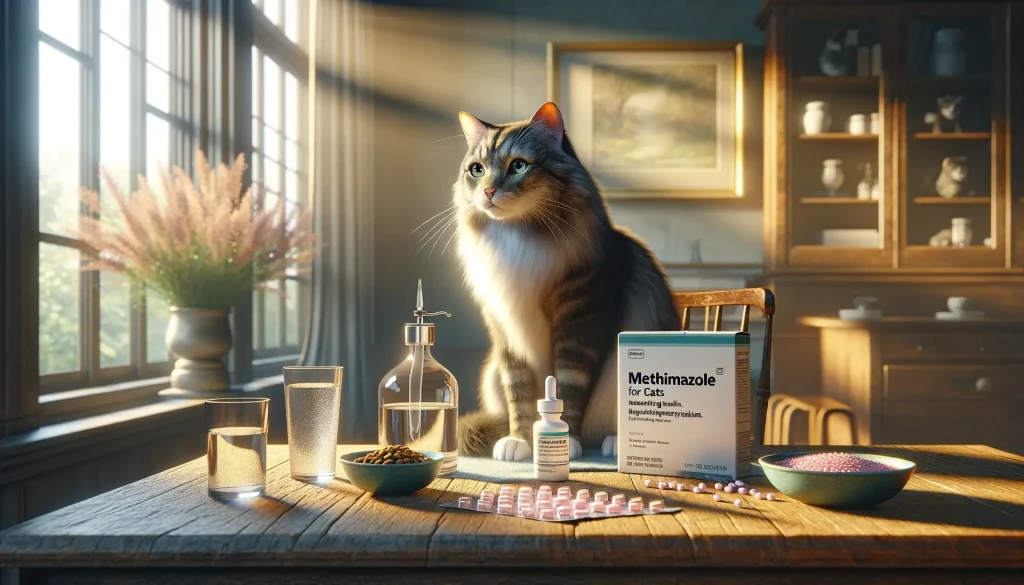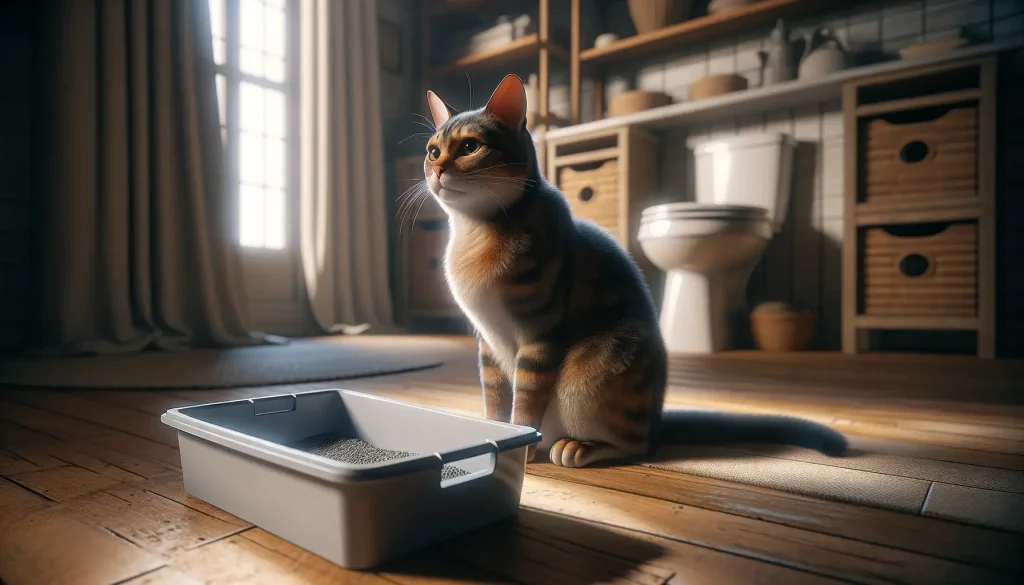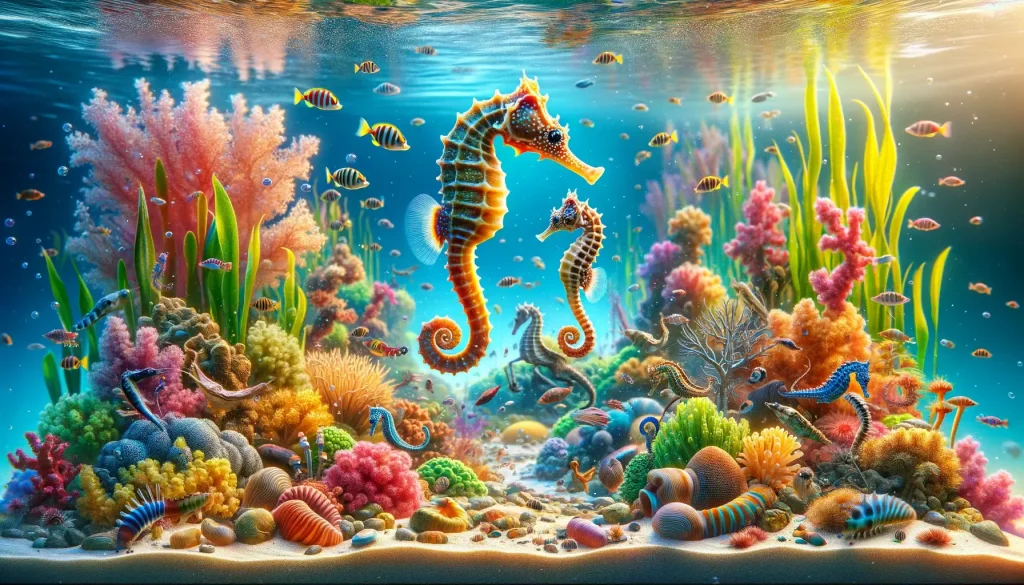
Insights into Pet Seahorses
Seahorses belong to the genus Hippocampus and are known for their distinctive appearance. Before diving into the world of seahorse care, it’s important to acknowledge that there are at least 47 different species, each with unique needs and characteristics. They can range in size from the tiny pygmy seahorse, less than an inch tall, to the large Australian big-bellied seahorse, measuring over 11.8 inches. Understanding their natural habitat, diet, and breeding habits is crucial for creating a safe and comfortable environment in your aquarium. But how do you provide the best care for these marine fish, ensuring they thrive under your watchful eye?
FAQs on Seahorse Care
What are seahorses?
Seahorses are a type of small marine fish belonging to the genus Hippocampus. They’re recognized for their horse-like head, monkey-like tail, and the unique fact that male seahorses carry the offspring.
How many species of seahorses are there?
There are at least 47 known species of seahorses, but this number may increase with further research. Each species has distinct needs and characteristics.
How big do seahorses get?
Seahorses vary in size. They can be as small as less than an inch, like the pygmy seahorse, or as large as over 11.8 inches, like the Australian big-bellied seahorse.
What do seahorses eat?
Their diet mainly consists of small crustaceans such as amphipods. Seahorses are frequent feeders, eating 30 to 50 times a day if food is available. They have a tubular snout to suck in prey since they lack a stomach or teeth.
Where do seahorses live?
They inhabit seagrass beds, mangrove roots, and coral reefs in shallow temperate and tropical waters. Some species can also be found in estuaries.
How do seahorses breed?
Seahorse breeding is unique. Females transfer the eggs to the male, who fertilizes them in his pouch. Gestation varies, and males can give birth to up to 1,500 offspring, depending on the species.
What threats do seahorses face?
Human activities pose significant threats to seahorses, including hunting for traditional medicine, souvenirs, and the pet trade. They also face dangers from bycatch, habitat loss, and climate change.
Are seahorses endangered?
Some seahorse species are listed as Vulnerable or Endangered. Conservation efforts are crucial for their protection and survival.
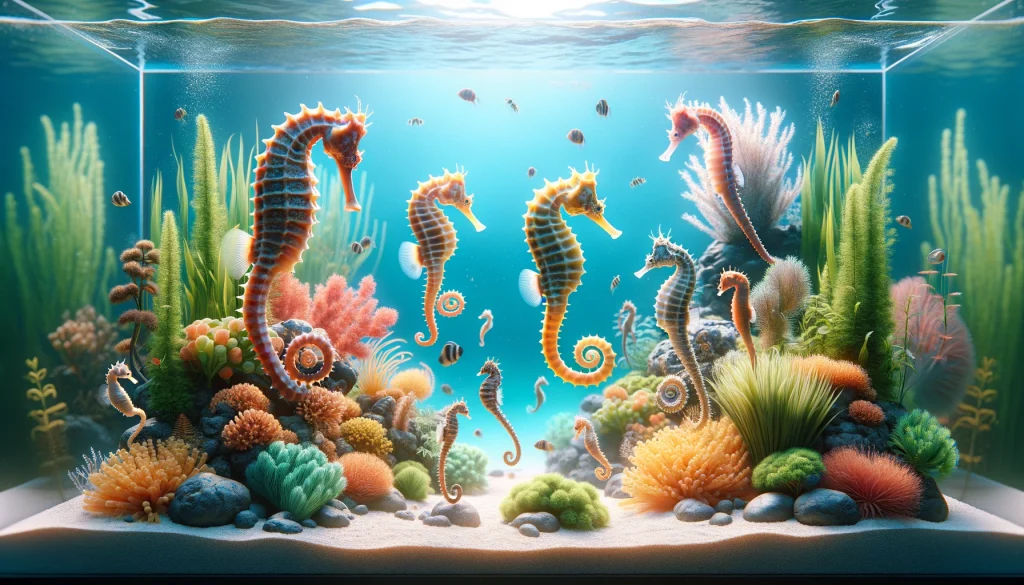
Seahorse Aquarium Setup
When it comes to setting up an aquarium for seahorses, there are several key factors you must consider to ensure a healthy and suitable environment for these unique creatures. First, it’s essential to understand that seahorses need a stable, well-maintained habitat to thrive. This section will walk you through the process of creating the perfect home for your seahorse, focusing on tank size, water parameters, and decoration.
Tank Size Matters
The size of your tank is crucial for the health and happiness of your seahorse. Due to their poor swimming abilities, seahorses prefer tall tanks that give them enough vertical space to latch onto and rest. A minimum tank height of 18 inches is recommended, though bigger is always better. For a pair of small to medium-sized seahorses, a 30-gallon tank is a good starting point. Larger species and groups will require more space.
Water Parameters: Quality is Key
Maintaining pristine water conditions is non-negotiable in seahorse care. Seahorses are sensitive to changes in their environment, making filtration and frequent water testing for ammonia, nitrite, nitrate, and pH levels mandatory. Ideal water temperatures range from 72 to 78 degrees Fahrenheit, with a specific gravity of 1.020-1.025. Regular water changes, at least 10-20% biweekly, help keep these parameters stable.
Creating a Seahorse Haven
Decorating your tank is not just about aesthetics; it’s about creating an environment that mimics their natural habitat. Seahorses need plenty of hitching posts, such as soft corals, macroalgae, or artificial seagrass, where they can anchor themselves with their prehensile tails. These items also offer hiding spots that help seahorses feel secure. Avoid strong currents in the tank, as seahorses are not strong swimmers.
Seahorse Secrets Unveiled
Ever wonder about the unique traits of seahorses beyond their care? Let’s dive into some interesting facts about these marine creatures that set them apart in the underwater world.
- Masterful Camouflage: Seahorses are experts in blending with their surroundings. They can change color and grow skin filaments to mimic plants and corals around them. This skill helps them sneak up on prey and hide from predators.
- Remarkable Eyes: The eyes of a seahorse can move independently, allowing them to look forward and backward at the same time. This 360-degree vision helps them spot food and danger without moving.
- Unique Swimming: Unlike most fish, seahorses swim upright. They use their dorsal fin to move forward and pectoral fins, located near their head, for steering and stability. Despite their peculiar swim style, seahorses are not strong swimmers and prefer to anchor themselves with their tails.
- Role Reversal: Seahorses are famous for their breeding behavior, where males carry the offspring. Females transfer eggs into the male’s brood pouch, where he fertilizes and carries them until birth, ranging from 10 days to 6 weeks depending on the species.
- Variable Lifespan: Seahorses have differing lifespans based on their environment and species. While some may live for a year, others can thrive up to five years or more in captivity, emphasizing the need for proper care and environment.
- Concerning Conservation Status: With some species listed as Vulnerable or Endangered, seahorses face threats from human activities, such as bycatch and habitat destruction. Conservation efforts are vital for their survival, highlighting the importance of responsible pet ownership and ecological awareness.
Knowing these fun facts not only enriches your understanding of seahorses but also enhances your appreciation for these enchanting creatures. As pet owners and ocean enthusiasts, it’s our responsibility to ensure the survival and well-being of seahorses, both in our homes and in the wild.
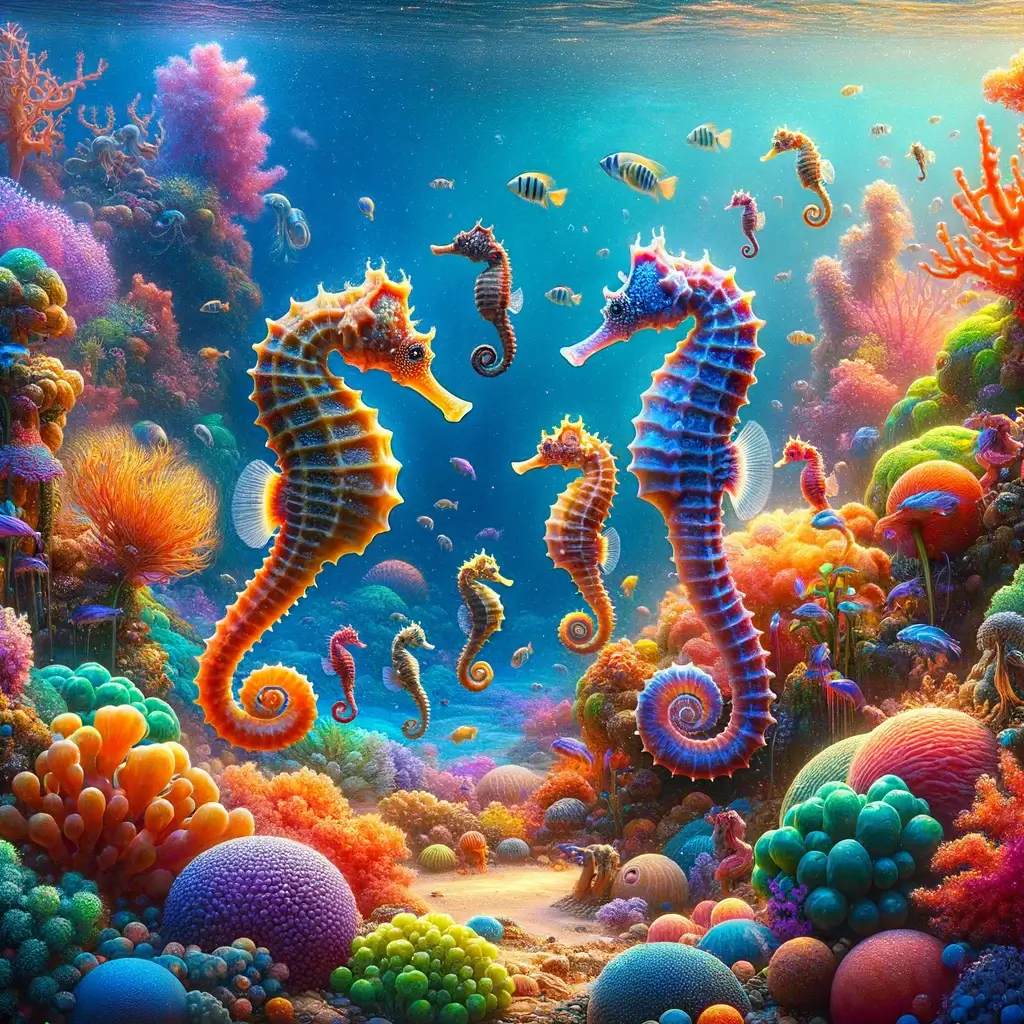
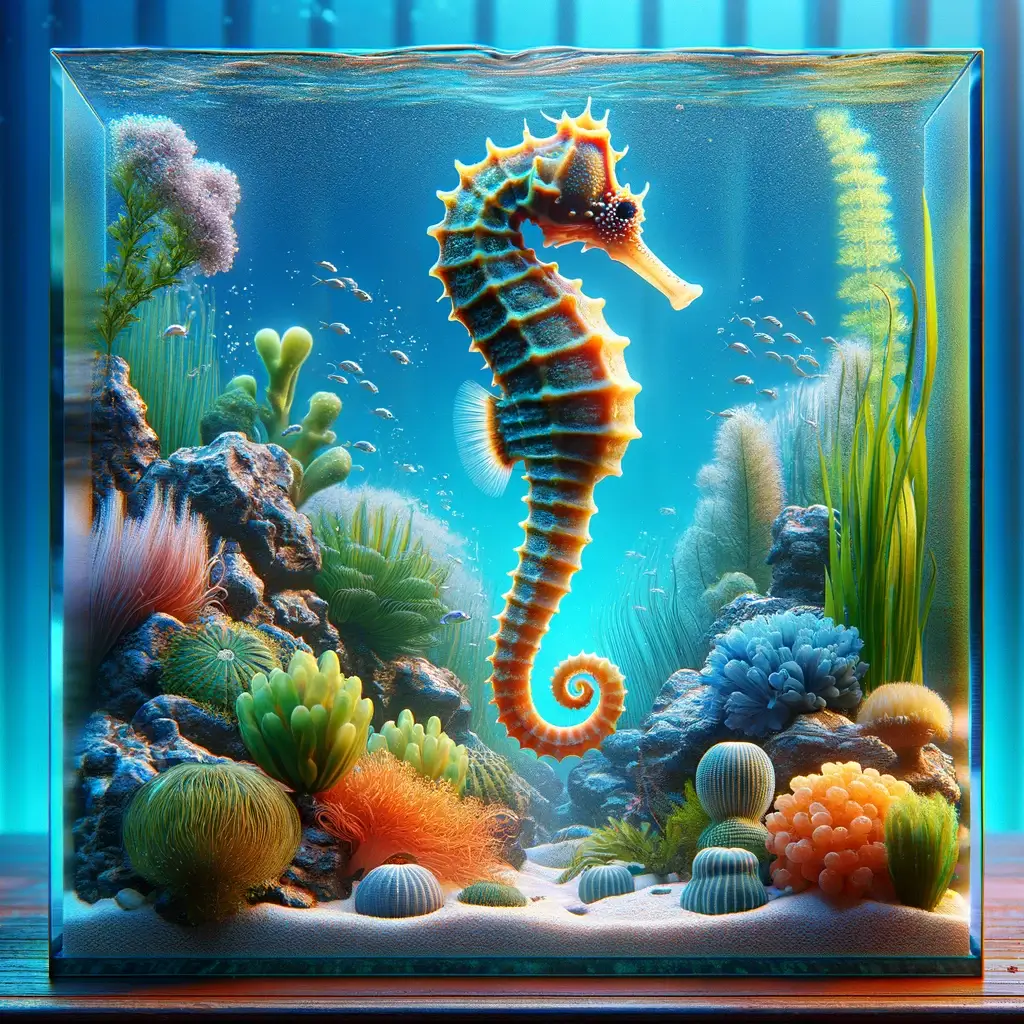
Easy Steps to a Happy Seahorse Life
Seahorses fascinate with their distinctive shapes and graceful movements. But their care is intricate. This section breaks down complex needs into manageable tasks. Apply these tips for a thriving seahorse set-up.
Tank Set-up and Maintenance
Start with the right tank. Seahorses need tall tanks for vertical movement. An 18-inch height is a minimum. For water quality, invest in a reliable filtration system. Test water parameters regularly. Aim for a temperature of 72 to 78 degrees Fahrenheit. Stable conditions mimic their natural environment, reducing stress.
Choose Compatible Tank Mates
Seahorses are peaceful but can be outcompeted for food by faster, more aggressive fish. Select tank mates with care. Good choices include small, gentle fish and invertebrates that won’t stress or harm your seahorse.
Diet and Feeding Practices
Nutrition is key. Seahorses eat small crustaceans. In captivity, they may be fed frozen mysis shrimp. They require feeding 2-3 times daily. Watch their eating habits closely. Each seahorse has its preferences and feeding style.
Creating a Seahorse-Friendly Habitat
Mimic their natural habitat. Include seagrass, soft corals, or artificial plants for them to latch onto. These hitching posts are crucial for their rest and feeding behavior. Avoid strong currents that could exhaust them.
Seahorse Feeding Essentials
Understanding what seahorses eat is essential for their care. Seahorses are predators that focus on tiny crustaceans. Here’s a breakdown of their dietary needs and how to cater to them in captivity.
Natural Diet: In the wild, seahorses consume small crustaceans like amphipods. Their method of eating is unique. They use their long snout to suck in prey. Since they don’t have stomachs, food passes quickly through their digestive system. This means they need to eat often.
Feeding in Captivity: To replicate their natural diet, offer your seahorse frozen mysis shrimp. These are rich in nutrients and close to what they would eat in their natural habitat. Seahorses need to be fed 2-3 times a day. This frequent feeding schedule supports their fast metabolism.
Observation is Key: Watch how your seahorse eats. Each one might have a different preference or approach to feeding. Adjust their diet according to what they prefer and how well they are eating.
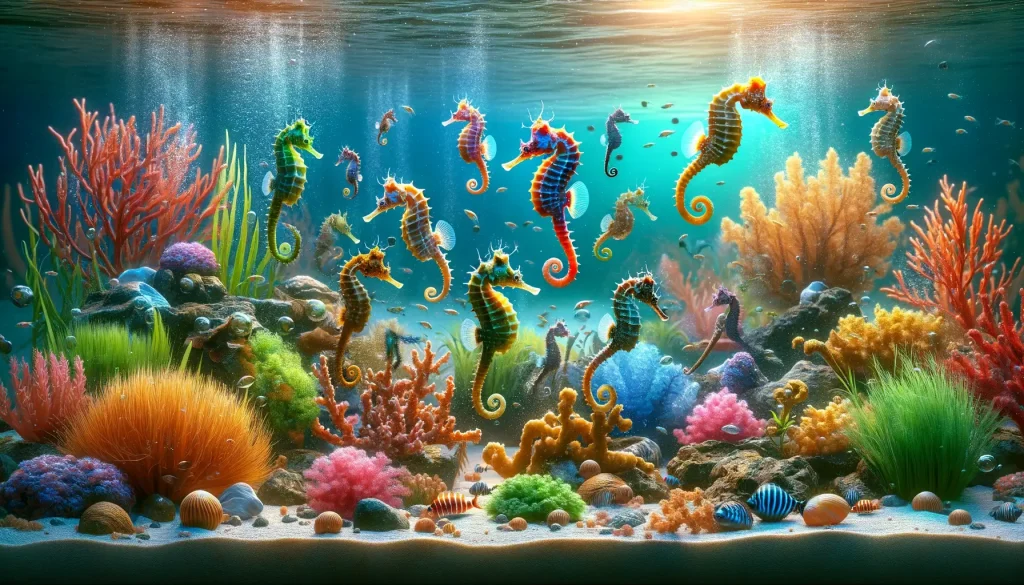
Seahorse Biology and Adaptations
Seahorses are among the most extraordinary creatures of the marine world, with their distinct head shape, prehensile tails, and slow, hovering movements. Here’s a deeper look into the biology and adaptations of seahorses that enable them to survive in their underwater habitats.
Unique Physical Traits
Seahorses have a myriad of unique features setting them apart. Their horse-like heads allow for pinpoint precision as they target food, while the prehensile tails enable them to anchor in flowing waters. Unlike most fish, seahorses are covered with an exoskeleton made of hard, bony plates, providing protection while allowing flexibility.
Exceptional Camouflage Abilities
Masters of disguise, seahorses can change color and grow skin filaments to blend seamlessly with their surroundings, a vital adaptation for both hunting and avoiding predators. This camouflage extends beyond mere color change, adapting to the textures of their environment.
Diet and Feeding Mechanism
Seahorses consume small crustaceans such as amphipods, feeding 30 to 50 times daily if possible. Their tubular snouts act as vacuum pumps, drawing in prey from a distance. The absence of a stomach demands frequent feeding, as food passes through their digestive systems quickly.
- Habitat and Distribution: Found in temperate and tropical waters, seahorses favor environments like seagrass beds, mangrove roots, and coral reefs, offering ample hiding spots and feeding opportunities. Their range includes vast areas across the West Atlantic and the Indo-Pacific region.
- Breeding and Reproduction: Seahorses are known for their unique reproductive behavior, where males carry and birth the young. This role reversal ensures higher survival rates for offspring as males can nurture them in the safety of their pouches.
- Lifespan: Depending on the species and environmental conditions, seahorses can live from one to over five years in captivity. Lifespan varies widely, influenced by factors such as diet, predation, and habitat quality.
Conservation and Threats
Despite their fascinating nature, seahorses face numerous threats. Habitat destruction, climate change, and human exploitation for traditional medicine and souvenirs put their populations at risk. Conservation status varies, with several species listed as Vulnerable or Endangered. Protecting these creatures requires global effort and sustainable practices.
Beginner Guide to Raising Quail at Home
What are the Signs of a Dog Concussion?
What Causes Your Dog’s Ears to Smell Bad?
When your dog’s ears start to emit an unpleasant odor, it might leave you puzzled…
Methimazole Treatment for Cat Hyperthyroidism
Methimazole plays a crucial role in managing feline hyperthyroidism, a condition marked by an overactive…
Got Hummingbirds in your Backyard? Here’s How to Care for Them.
Why Does Your Cat Pee Outside the Litter Box?
Cat’s Litter Box Issues It’s not uncommon for cat owners to face the frustrating dilemma…



